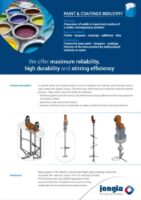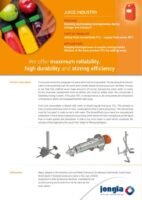Precipitation and crystallization are both processes involved in the formation of solid substances from a solution, but they occur under different conditions and result in different outcomes.
1. Precipitation:
- Precipitation occurs when a solid substance forms from a solution as a result of a chemical reaction or a change in solubility conditions (such as temperature or pressure).
- In precipitation, the solid substance forms as fine particles dispersed throughout the solution. These particles then settle out of the solution due to gravity.
- The formation of precipitates often involves the reaction of two or more soluble substances to produce an insoluble product. For example, mixing solutions of silver nitrate and sodium chloride results in the precipitation of silver chloride.
2. Crystallization:
- Crystallization involves the formation of solid crystals from a solution or a melt (liquid).
- It occurs when the solute molecules or ions in a solution come together in a specific arrangement to form a crystalline solid.
- Crystallization can be achieved through various methods such as cooling a saturated solution, evaporating the solvent, or adding a precipitating agent.
- The resulting crystals typically have a well-defined geometric shape and structure due to the ordered arrangement of atoms or molecules within the crystal lattice.
In summary, while both precipitation and crystallization involve the formation of solid substances from a solution, precipitation typically involves the formation of fine particles dispersed throughout the solution due to a chemical reaction or change in solubility conditions, whereas crystallization involves the formation of well-defined crystals with a specific geometric structure from a solution or melt.
When agitators are applied in precipitation and crystallization processes, they influence the rate and characteristics of the resulting solid formation in different ways:
1. Precipitation with Agitation:
- Agitation in precipitation processes helps to enhance mixing and promote the interaction between reactants, thereby accelerating the formation of precipitates.
- Agitation prevents localized saturation and ensures uniform distribution of reactants throughout the solution, leading to the formation of finer precipitate particles.
- The use of agitators in precipitation processes can also facilitate the removal of precipitates from the solution by preventing their settling and promoting suspension.
- However, excessive agitation may lead to the formation of smaller, less-defined precipitate particles and can sometimes result in unwanted side reactions or impurities due to increased contact between reactants.
2. Crystallization with Agitation:
- Agitation in crystallization processes is commonly used to maintain a uniform solution concentration and temperature throughout the vessel.
- Agitation prevents localized supersaturation and encourages the nucleation of crystals at various points within the solution, promoting the formation of numerous smaller crystals rather than a few large ones.
- In crystallization, the use of agitators helps to control crystal size distribution, enhance crystal purity, and improve the overall yield of the desired product.
- Agitation also aids in preventing crystal adhesion to vessel walls or equipment surfaces, which can hinder the growth of crystals and affect product quality.
- However, excessive agitation in crystallization processes may lead to the production of fine crystals with irregular shapes, which can affect downstream processing and product recovery.
In summary, while agitation plays a crucial role in both precipitation and crystallization processes by promoting mixing and maintaining uniform conditions, its effects differ depending on the specific objectives and mechanisms involved in each process. In precipitation, agitation primarily accelerates the formation of fine precipitate particles and aids in their suspension, while in crystallization, it helps control crystal size distribution, purity, and yield.
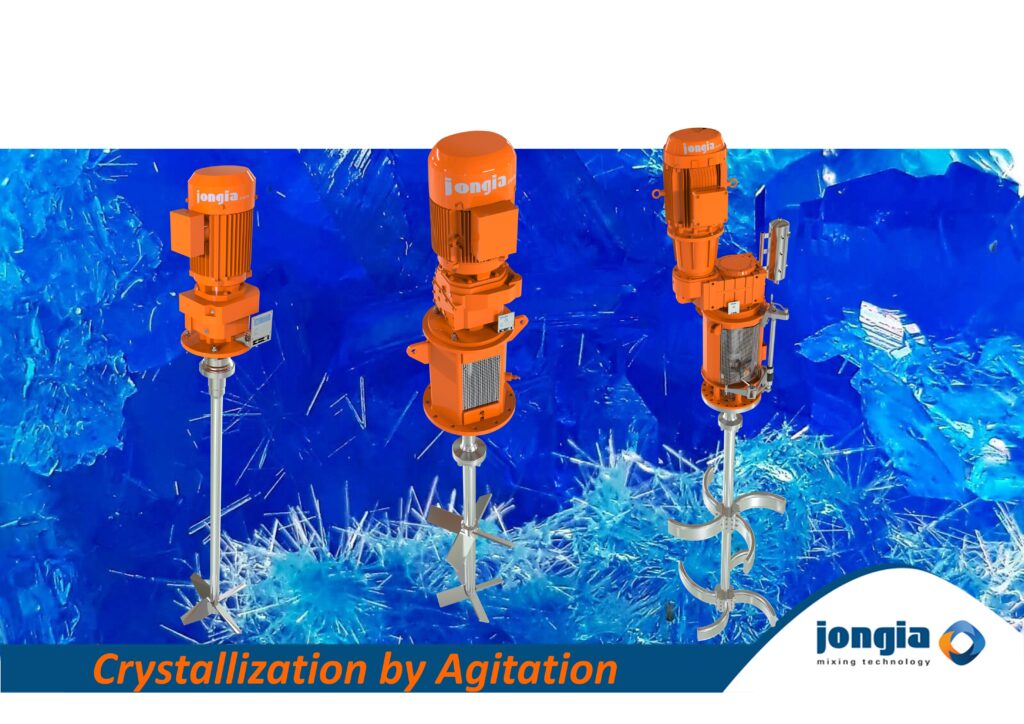
What are the differences in Precipitation and Crystallization when Agitation is applied?
Precipitation and crystallization are processes that result in the formation of solids from solutions, though they operate under distinct conditions and lead to different products.
1. Precipitation:
- Precipitation occurs when a solid forms in a solution due to a chemical reaction or a change in conditions like temperature or pressure.
- The solid appears as fine particles scattered throughout the solution, which eventually settle out due to gravity.
- A typical example of precipitation is the formation of silver chloride from solutions of silver nitrate and sodium chloride.
2. Crystallization:
Crystallization is the process of forming solid crystals from a solution or melt.
- This process takes place when solute molecules or ions arrange in a structured pattern to form a crystalline solid.
- Methods to induce crystallization include cooling a saturated solution, evaporating the solvent, or adding a precipitating agent, resulting in crystals with a defined geometric shape and structure.
Agitation affects precipitation and crystallization differently:
1. Precipitation with Agitation:
- Agitation enhances mixing and reactant interaction, speeding up precipitate formation.
- It ensures even distribution of reactants, preventing localized saturation and promoting the formation of finer precipitate particles.
- Using agitators can keep precipitates suspended, aiding in their removal, though excessive agitation might reduce particle size and introduce impurities.
2. Crystallization with Agitation:
- Agitation in crystallization ensures uniform concentration and temperature, preventing localized supersaturation and promoting multiple nucleation sites.
- It controls crystal size, improves purity, and increases yield, while also preventing crystals from sticking to vessel walls or equipment.
- Excessive agitation, however, may lead to the formation of irregular, fine crystals, potentially complicating downstream processing and recovery.
In conclusion, while both processes form solids from solutions, precipitation typically generates dispersed fine particles through chemical reactions or solubility changes. In contrast, crystallization yields well-defined crystals from a structured arrangement of molecules or ions.
Agitation plays a critical role in both, enhancing mix and maintaining conditions, but its specific effects vary between the processes.
Adding an agitator to a precipitation process brings several benefits, enhancing the overall efficiency and quality of the precipitate formation.
Here are the key advantages:
1. Improved Mixing and Reactant Interaction: Agitators facilitate thorough mixing of reactants in the solution, ensuring that the reactant molecules are uniformly distributed. This improved mixing helps to maximize the interaction between the reactants, which is crucial for achieving efficient and complete precipitation.
2. Uniform Distribution of Reactants: By preventing localized concentrations of chemicals, agitation ensures that reactants are evenly distributed throughout the solution. This uniformity helps to avoid areas of excessive or insufficient reactant concentrations, which can lead to uneven precipitation and poor product quality.
3. Enhanced Rate of Precipitation: Agitation can accelerate the kinetics of the chemical reactions involved in precipitation. The constant movement helps to expose more reactant molecules to each other, speeding up the reaction rate and thus the formation of precipitates.
4. Control over Particle Size and Shape: Agitation can influence the size and morphology of the precipitate particles. Properly controlled agitation results in finer particles by preventing them from growing too large, which can be beneficial for subsequent processing steps, such as filtration and drying.
5. Prevention of Particle Agglomeration: Without agitation, precipitate particles may clump together or agglomerate, making them harder to process later. Agitation keeps the particles in suspension and dispersed, reducing the likelihood of agglomeration.
6. Facilitates Continuous Operation: In industrial processes, continuous addition and removal of materials are facilitated by agitation. This allows the precipitation process to be part of a continuous production line, enhancing efficiency and scalability.
7. Improves Heat Transfer: In precipitation reactions where temperature changes are involved, agitators can help maintain a consistent temperature throughout the solution. This uniform temperature distribution is important for reactions that are sensitive to thermal variations.
Overall, the use of an agitator in precipitation processes can lead to more controlled, efficient, and high-quality outcomes, making it an essential component in many chemical manufacturing operations.
Adding an agitator to a crystallization process offers numerous benefits that enhance the control, efficiency, and quality of the crystalline product. Here are the primary advantages:
- Uniform Solution Conditions: Agitation ensures that the concentration of solute and the temperature are consistent throughout the solution. This uniformity is crucial for preventing localized supersaturation, which can lead to uncontrolled nucleation and growth of crystals.
- Enhanced Nucleation Control: By maintaining a uniform environment, agitation helps manage the rate and location of nucleation. Controlled nucleation is key to achieving desired crystal sizes and shapes, as it allows for a more predictable and repeatable crystallization process.
- Improved Mass Transfer: Agitation enhances the transfer of solute molecules to the growing crystal surfaces. This improved mass transfer can increase the rate of crystal growth and help achieve more complete crystallization, reducing the amount of residual solute in the mother liquor.
- Prevention of Crystal Agglomeration: In the absence of sufficient mixing, crystals can clump together, forming agglomerates that are difficult to break apart and process. Agitation keeps crystals suspended and separate, promoting the growth of individual crystals rather than clusters.
- Control over Crystal Size and Quality: Agitators allow for better control over crystal size distribution. By adjusting the intensity and type of agitation, operators can influence whether the process produces many small crystals or fewer larger ones, which is crucial for the downstream processing and the quality of the final product.
- Reduction of Scaling and Fouling: Agitation can prevent crystals from adhering to the walls of the crystallization vessel or to equipment surfaces, a phenomenon known as scaling or fouling. This is particularly important in continuous or semi-continuous processes, where buildup can lead to operational inefficiencies and increased maintenance costs.
- Enhanced Heat Transfer: Similar to its role in precipitation, agitation in crystallization helps maintain a uniform temperature throughout the vessel. Efficient heat transfer is essential in crystallization processes where the solubility of the solute is highly temperature-dependent.
- Facilitates Continuous Processing: Agitation supports the integration of crystallization processes into continuous manufacturing setups. It helps in the consistent feed of new material and removal of product, which is advantageous for large-scale production environments.
In summary, the use of an agitator in crystallization processes is crucial for optimizing crystal formation, achieving desired crystal characteristics, and ensuring efficient operation, all of which contribute to the production of high-quality crystalline products.
Agitation is a key factor in both processes, enhancing mixing, controlling particle formation, and ensuring uniform conditions, albeit with effects that vary significantly between the two processes. These differences underline the importance of choosing the right Mixing method based on the desired outcome in industrial settings.
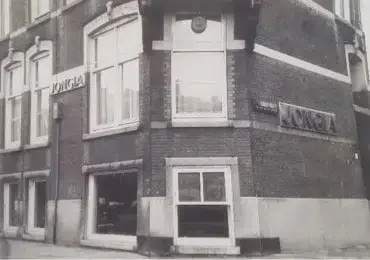
Our History
From the moment Jongia was founded in 1937 we have been evolving structurally over the years. Learn more about our company’s history with the summary of most important moments highlighted in a timeline.
Related News
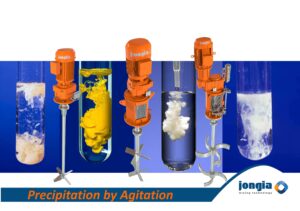
Precipitation by agitation
Precipitation is a fundamental concept in chemistry and can occur under different conditions, including with and without agitation. Let’s explore these scenarios to understand how they affect the precipitation process. Precipitation With Agitation Precipitation with agitation involves mechanical stirring or
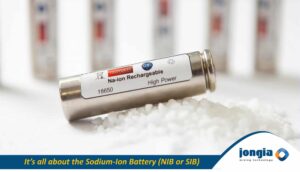
Is Sodium-Ion the next generation sustainable Battery?
The sodium-ion battery (NIB or SIB) is a type of rechargeable battery that uses sodium ions (Na+) as its charge carriers. Its working principle and cell construction are almost identical with those of lithium-ion battery (LIB) types, but replace lithium with sodium.
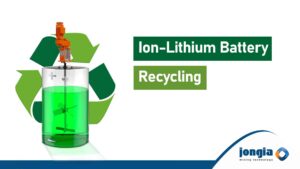
What is the recycling process for lithium
Current commercial lithium ion batteries mainly contain transition metal oxides or phosphates, aluminum, copper, graphite, organic electrolytes containing harmful lithium salts, and other chemicals. Therefore, the recycling and reuse of spent lithium ion batteries has been paid more and more




